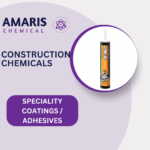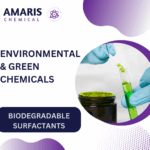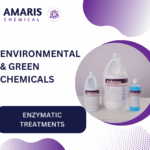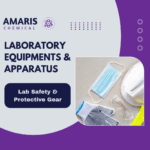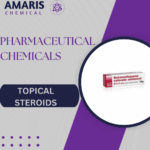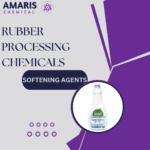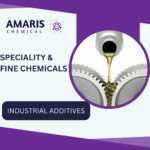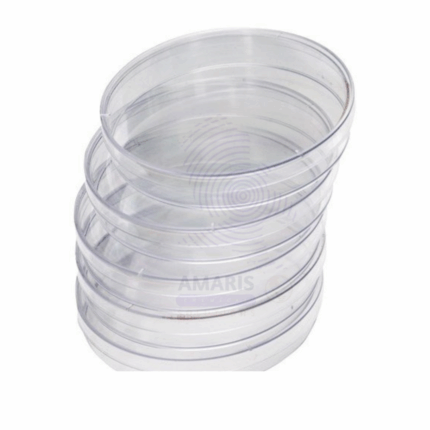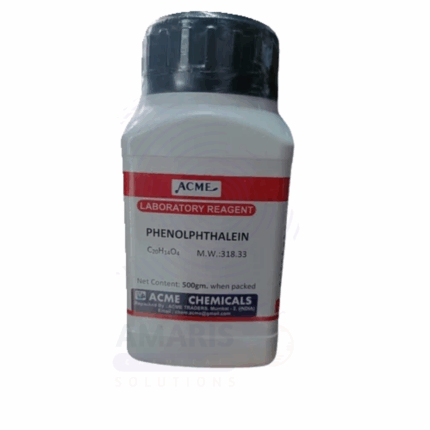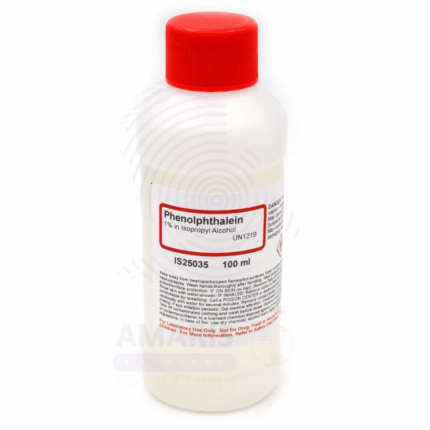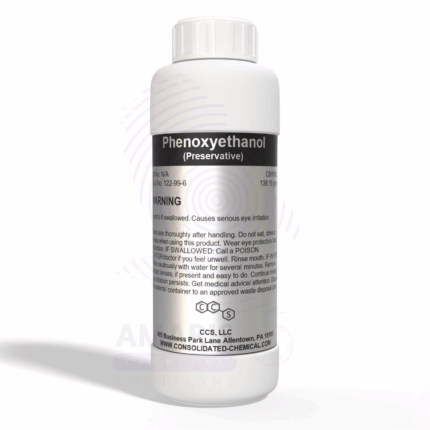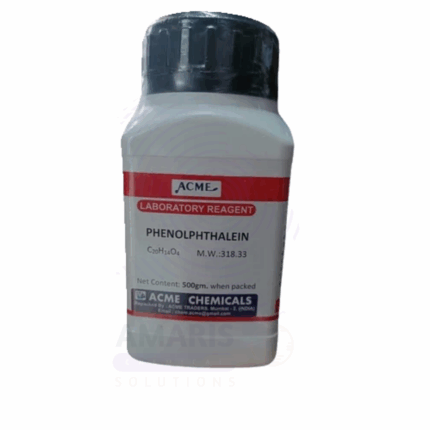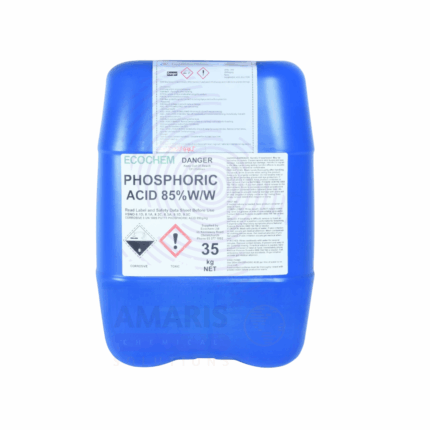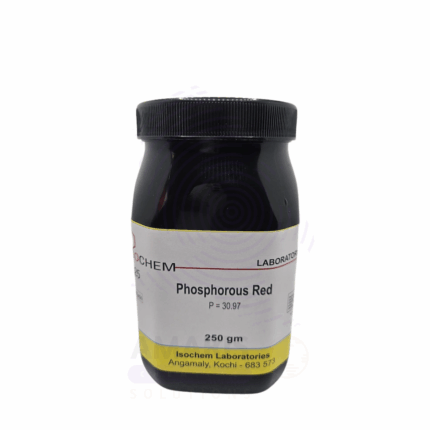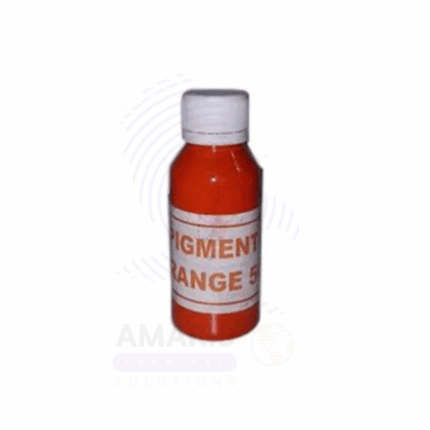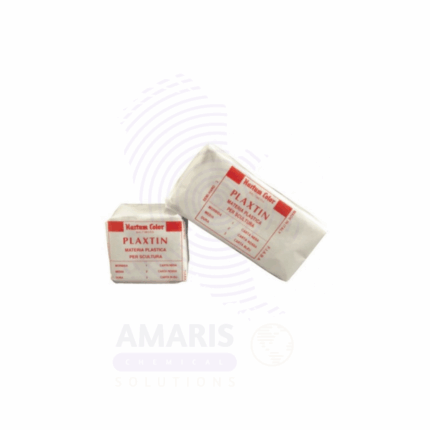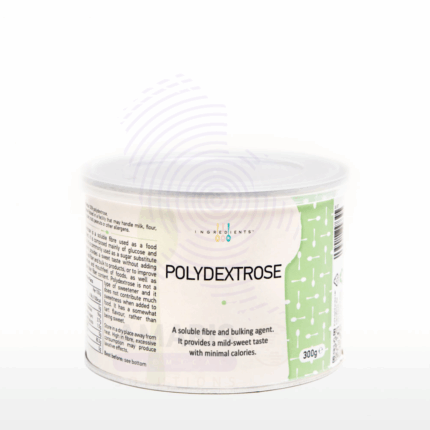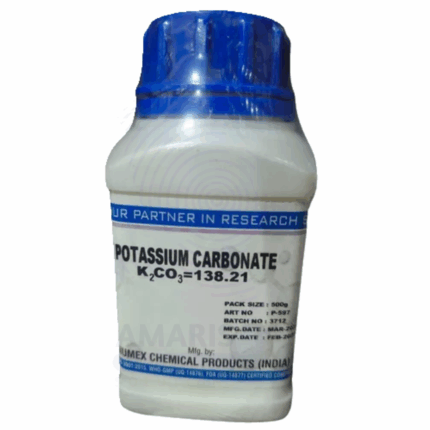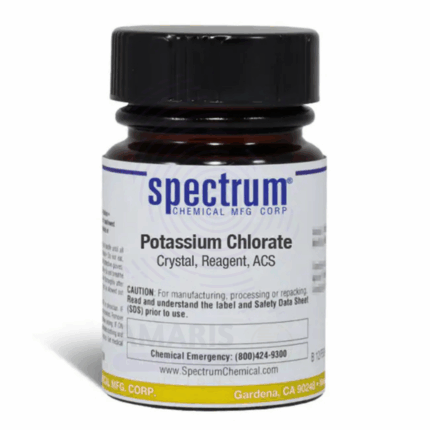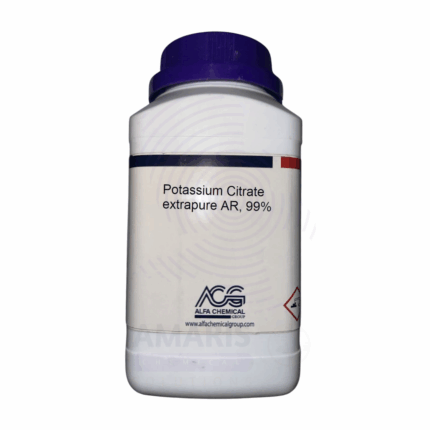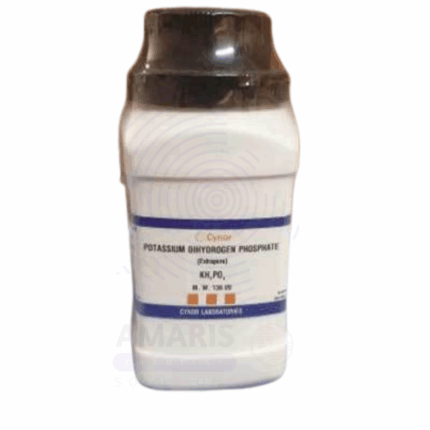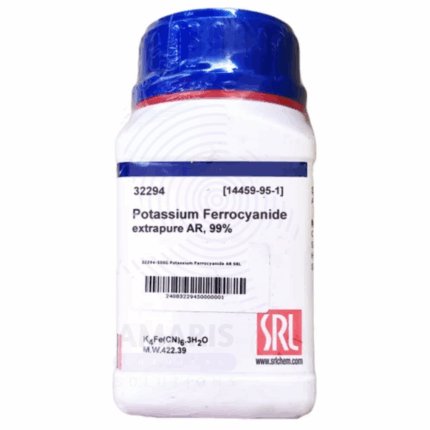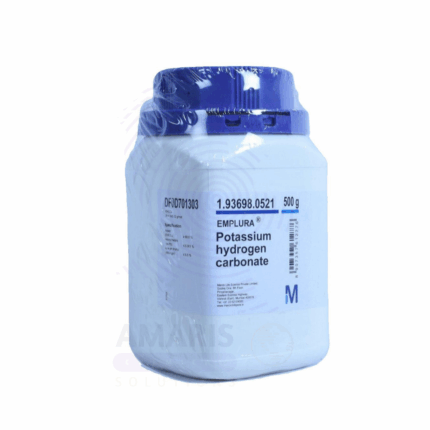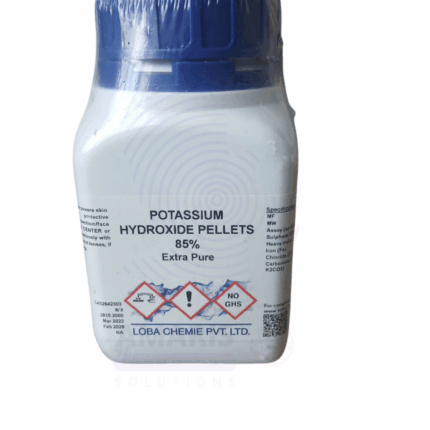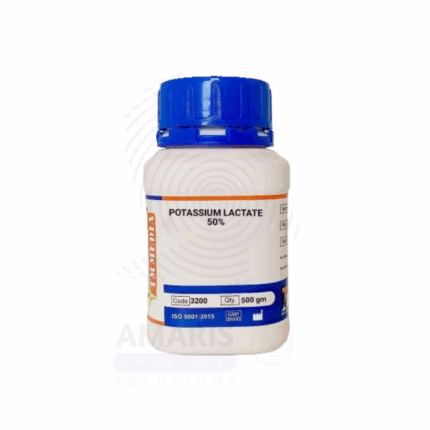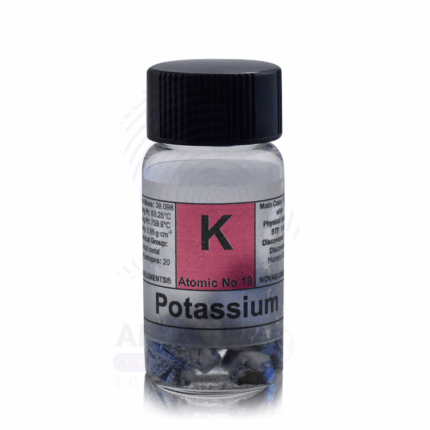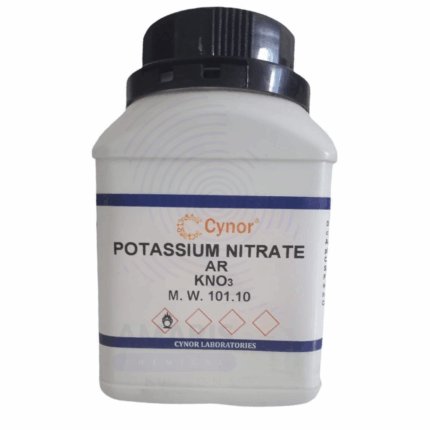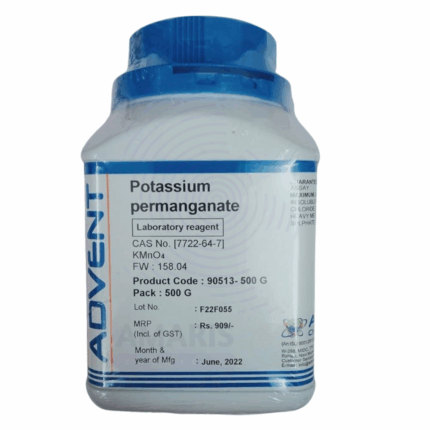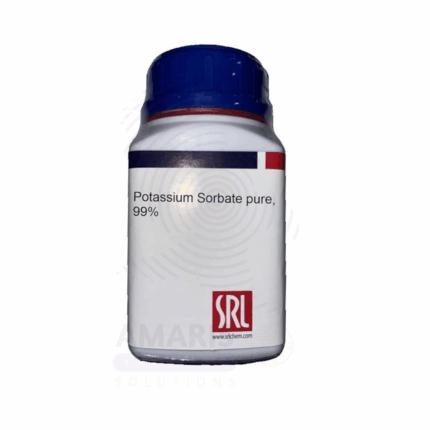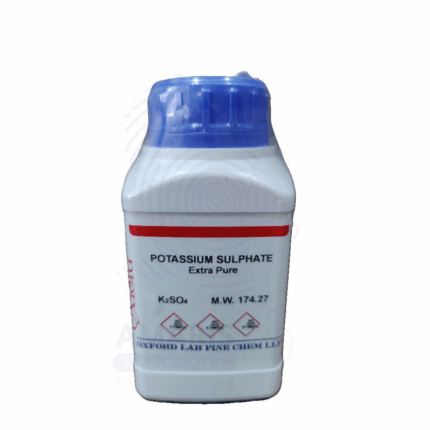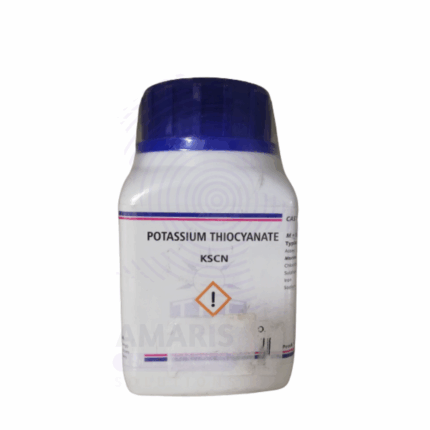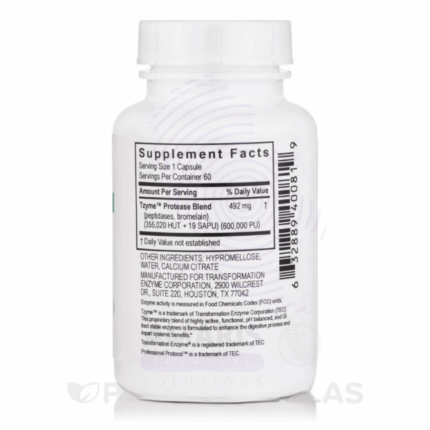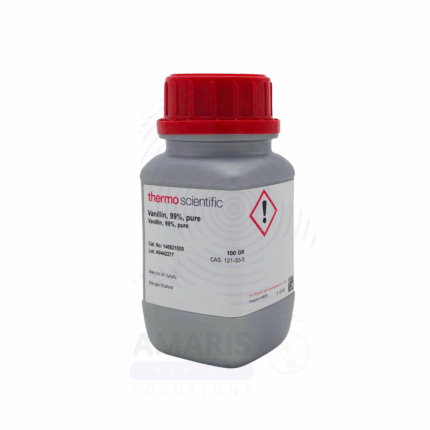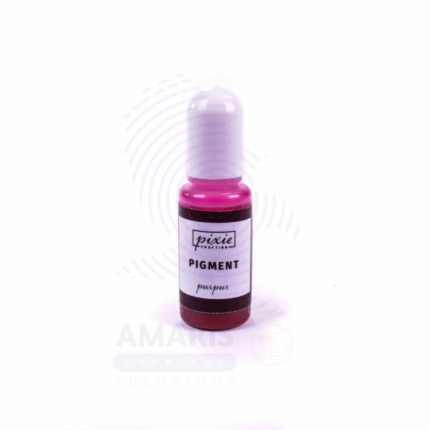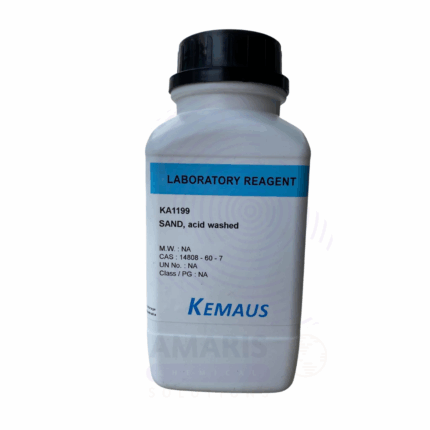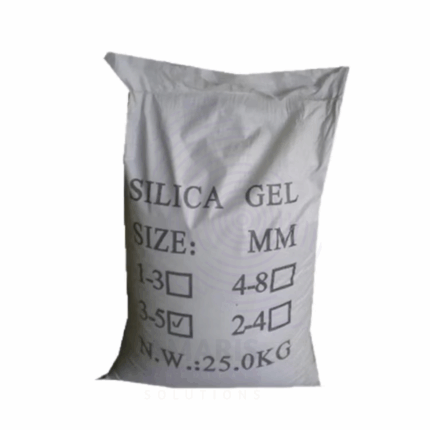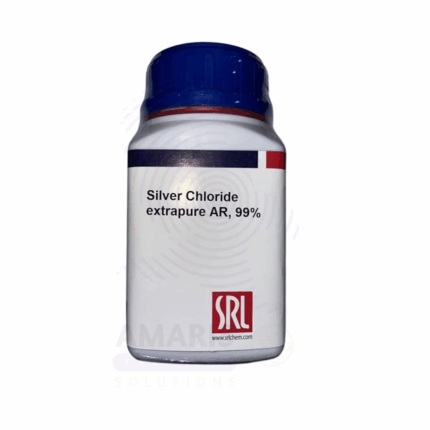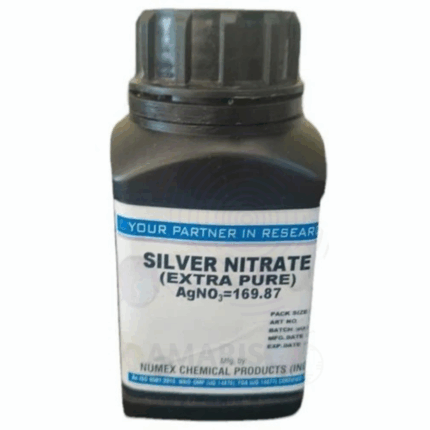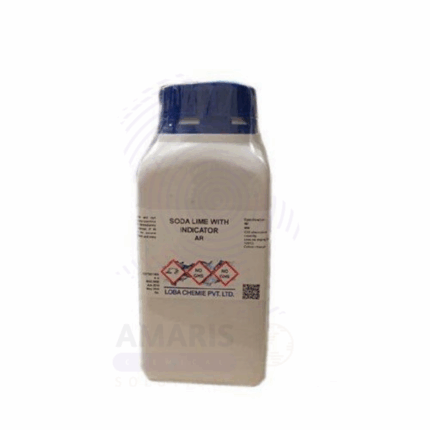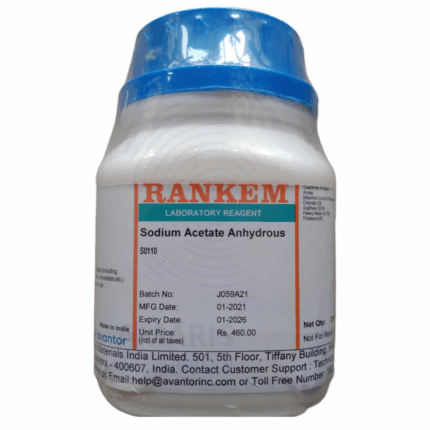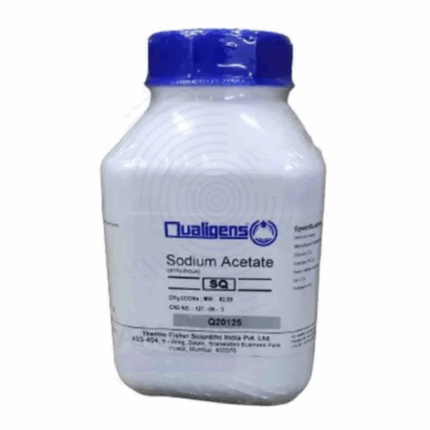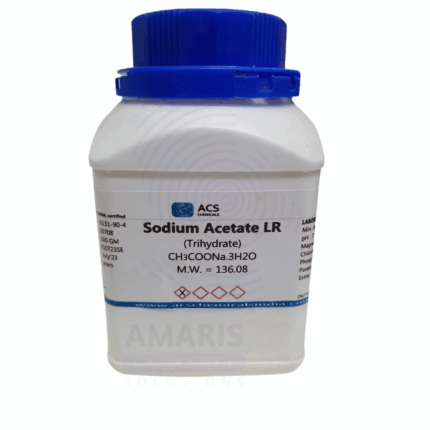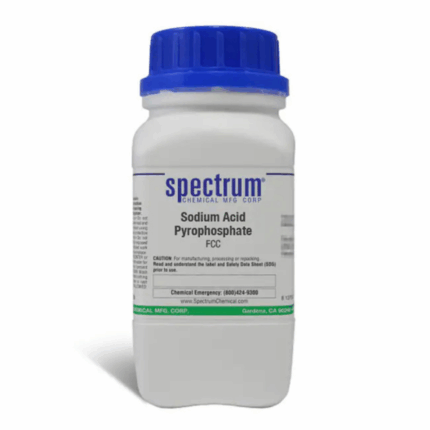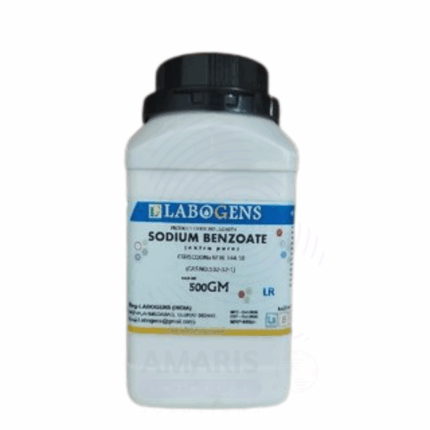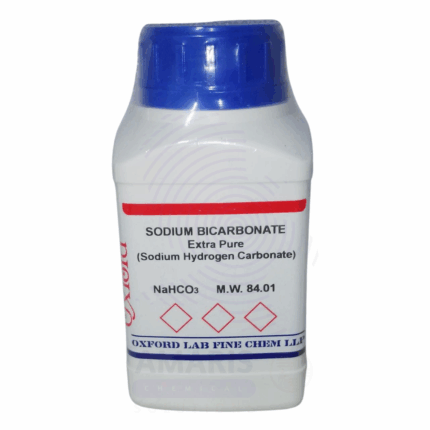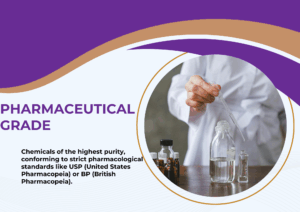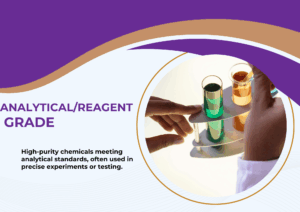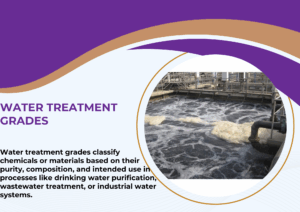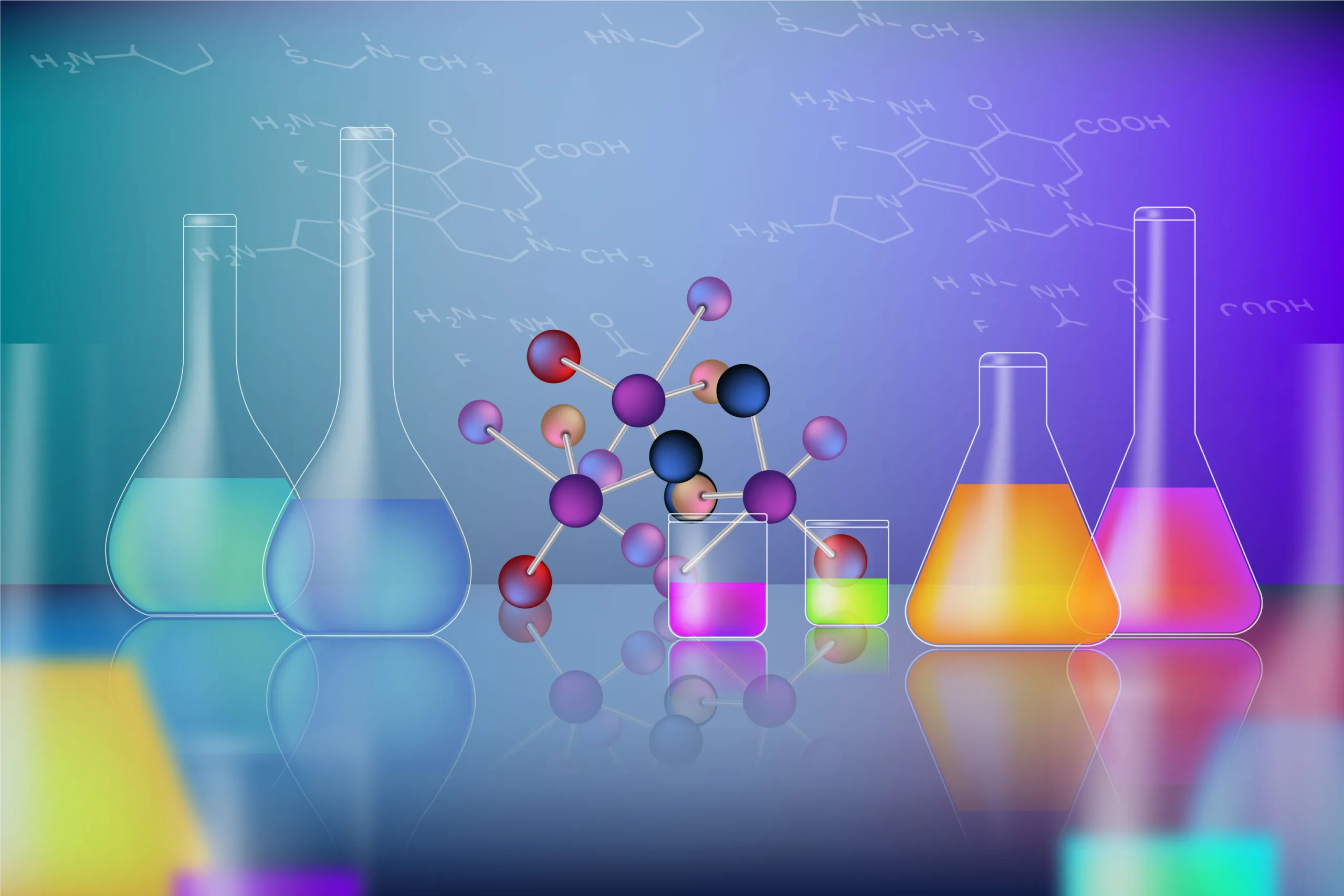
Pepsin Extra Pure
Pepsin Extra Pure is a highly refined proteolytic enzyme derived from porcine gastric mucosa, widely recognized for its ability to break down proteins into peptides. Appearing as a white to off-white, amorphous powder, it retains strong enzymatic activity and is soluble in dilute acids, making it ideal for biological and analytical applications.
This Extra Pure grade is extensively used in biochemical research, pharmaceutical formulations, digestive studies, and food processing, particularly in the production of protein hydrolysates. It plays a crucial role in simulating gastric digestion in lab experiments and is also employed in diagnostic preparations and enzyme assays. Pepsin should be stored in a tightly sealed container under refrigerated conditions to maintain its activity, and care should be taken to avoid exposure to moisture and alkaline conditions, which can denature the enzyme.
PETRI DISH PLASTIC
Petri Dish Plastic is a shallow, cylindrical laboratory container made from clear, chemically resistant plastic materials such as polystyrene or polypropylene. Designed for single-use or limited reuse, plastic Petri dishes provide a convenient and cost-effective alternative to glass, especially in applications where sterility and disposability are priorities. These dishes are commonly used in microbiology, cell
Phenolphthalein Powder Extra Pure
Phenolphthalein Powder Extra Pure is a high-purity pH indicator extensively used in analytical chemistry and laboratory applications. This fine, white to pale pink crystalline powder is colorless in acidic solutions but turns a vivid pink to deep magenta in basic environments, typically transitioning around a pH of 8.2 to 10.0. Its sharp and distinct color change makes it ideal for acid-base titrations, particularly in educational, industrial, and research settings.
In addition to its primary role in titrations, Phenolphthalein is also used in various chemical formulations, soil pH testing, and sometimes as a dye component in forensic applications. Although previously used as a laxative, it is now restricted to laboratory use due to health concerns. It should be handled with care—using gloves, protective eyewear, and in well-ventilated areas—to avoid inhalation or prolonged contact. Store in a cool, dry place, away from strong oxidizers and light.
Phenolphthalein Solution Extra Pure
Phenolphthalein Solution Extra Pure is a laboratory-grade pH indicator solution, commonly used in titration procedures to determine the endpoint of acid-base reactions. It is prepared by dissolving phenolphthalein powder in an appropriate solvent, typically ethanol or water-alcohol mixtures, resulting in a clear, colorless solution that turns vivid pink in basic conditions—usually in the pH range of 8.2 to 10.0.
This high-purity solution offers excellent sensitivity and reliability for analytical chemistry, quality control, and educational demonstrations. It is especially favored in alkalinity testing, neutralization reactions, and various standard laboratory protocols. Proper handling is essential, including the use of gloves and eye protection, as the solution may cause skin or eye irritation upon contact. Store tightly sealed, away from direct light and incompatible substances like strong acids or oxidizers, to maintain its stability and effectiveness.
Phenoxyethano Extra Pure
Phenoxyethano Extra Pure is a high-purity aromatic glycol ether widely used as a preservative, solvent, and stabilizer in pharmaceutical, cosmetic, and laboratory formulations. This colorless, slightly viscous liquid possesses a mild pleasant odor and offers effective antimicrobial properties, particularly against Gram-negative bacteria.
Due to its excellent solvency and low volatility, Phenoxyethanol is ideal for use in creams, lotions, serums, and vaccines, where it extends shelf life by preventing microbial growth. In laboratory settings, it serves as a dependable solvent for dyes, resins, and plasticizers. Its low toxicity and compatibility with other preservatives make it a preferred alternative to parabens in personal care products.
Phloretin Extra Pure
Phloretin Extra Pure is a high-grade dihydrochalcone flavonoid renowned for its antioxidant, anti-inflammatory, and skin-penetration-enhancing properties. Derived from apples and certain other fruits, this compound appears as a pale-yellow crystalline powder and is sparingly soluble in water but dissolves well in ethanol and other organic solvents.
In cosmetic and dermatological applications, Phloretin is used to combat oxidative stress, brighten skin tone, and reduce the appearance of fine lines, pigmentation, and UV-induced damage. It also enhances the absorption of active ingredients across the skin barrier, making it a valuable addition to advanced skincare formulations.
In laboratory and pharmaceutical settings, it is utilized for research into cell signaling, anti-cancer mechanisms, and metabolic modulation, given its biological activity on various enzyme systems.
Phosphoric Acid Food Grade
Phosphoric Acid Food Grade is a highly concentrated, colorless, odorless liquid acid used extensively in the food and beverage industry. It acts as an acidulant, flavoring agent, and preservative, approved for direct use in food processing. This grade meets strict purity standards suitable for consumption and is widely employed to control pH, add tanginess, and extend shelf life. It is also used in other industries requiring high-purity phosphoric acid.
Phosphorous Red Extra Pure
Phosphorous Red Extra Pure is a high-purity allotrope of elemental phosphorus, presented as a dark red to violet amorphous powder. Unlike its white counterpart, red phosphorus is significantly more stable and less reactive at room temperature, making it safer to handle under controlled conditions. It is insoluble in water and most organic solvents and must be stored under inert conditions due to its flammability in finely divided form.
This grade of red phosphorus is commonly used in laboratories for chemical synthesis, pyrotechnics, match production, and flame retardant formulations. In education and research, it is employed in demonstrations of allotropy and in preparing organophosphorus compounds.
Pigment Orange Extra Pure
Pigment Orange Extra Pure is a high-quality organic pigment known for its bright, vibrant orange hue and excellent tinting strength. Comprising 20% active pigment content in a stable carrier base, this formulation ensures consistent dispersion and color intensity in various applications. It is finely milled for enhanced performance in both aqueous and solvent-based systems.
This pigment is widely used in paints, plastics, inks, coatings, and cosmetic formulations, where color consistency, purity, and chemical stability are critical. Its resistance to light, heat, and chemical degradation makes it ideal for both indoor and outdoor applications, particularly in artistic, industrial, and educational settings.
Due to its powdery nature, appropriate dust control and personal protective equipment (PPE) are recommended during handling. Store it in a cool, dry place away from direct sunlight and moisture to maintain its quality and performance.
Poly Aluminium Chloride Extra Pure
Poly Aluminium Chloride Extra Pure is a high-efficiency inorganic coagulant widely used in water treatment, paper manufacturing, and various industrial processes. In its extra pure grade, PAC is characterized by a high degree of purity, minimal impurities, and consistent performance, making it suitable for critical applications requiring stringent quality control.
PAC works by neutralizing the negative charges on suspended particles, allowing them to coagulate and settle quickly. It is highly effective in clarifying drinking water, treating industrial and municipal wastewater, and removing heavy metals, organic matter, and pathogens. Additionally, in the paper industry, PAC improves paper strength and retention of fillers.
This compound should be handled with appropriate PPE, including gloves and eye protection, and stored in a cool, dry, and well-ventilated area, away from reactive substances. PAC is non-flammable but may cause irritation on contact with skin or eyes.
Polydextrose Extra Pure
Polydextrose Extra Pure is a premium-grade synthetic polymer of glucose, widely used as a dietary fiber, bulking agent, and low-calorie carbohydrate substitute in food, pharmaceutical, and nutraceutical applications. Its high purity ensures suitability for laboratory, formulation, and quality-sensitive uses.
This compound is valued for its excellent solubility, neutral taste, and stability across a wide pH range and temperatures. It is commonly incorporated into sugar-free, low-calorie, or high-fiber food products such as baked goods, beverages, and nutritional supplements. In pharmaceutical formulations, it may serve as an excipient or filler in tablets and capsules.
Polydextrose is generally recognized as safe (GRAS) and well-tolerated, though excessive intake may have a mild laxative effect. It should be stored in a cool, dry place, sealed tightly to avoid moisture absorption.
Polyglyceryl Extra Pure
Polyglyceryl Extra Pure refers to a high-purity class of non-ionic surfactants and emulsifiers derived from glycerol units. These compounds are widely used in cosmetics, pharmaceuticals, and food formulations due to their excellent skin compatibility, emulsifying properties, and biodegradability.
Polyglyceryls come in various forms (e.g., Polyglyceryl-3, Polyglyceryl-6, Polyglyceryl-10), each offering different levels of hydrophilicity and emulsifying strength. In cosmetics, they help create stable oil-in-water emulsions, ideal for lotions, creams, cleansers, and sunscreens. In pharmaceuticals, their non-toxic and non-irritating nature makes them suitable carriers for active ingredients. In food products, they function as safe emulsifiers and stabilizers, supporting clean-label and natural product development.
This extra pure grade ensures low impurity levels, minimal odor, and consistent performance, making it ideal for sensitive applications. Store tightly sealed in a cool, dry place away from heat and light to maintain its stability and quality.
Potassium Chlorate Extra Pure
Potassium Chlorate Extra Pure is a high-purity, crystalline compound with the chemical formula KClO₃. It appears as a white, odorless solid and is well known for its strong oxidizing properties. In its Extra Pure form, it meets analytical-grade standards, making it suitable for sensitive laboratory and controlled industrial applications.
This chemical is extensively used in analytical chemistry, especially in oxygen production experiments and thermal decomposition studies, as it decomposes to release oxygen when heated. It is also used as a reagent in pyrotechnics, match compositions, and explosive formulations, where a powerful oxidizer is needed. In botanical tissue culture, potassium chlorate is sometimes used to induce flowering in certain plant species.
Due to its reactive and potentially explosive nature, Potassium Chlorate must be handled with extreme caution. It should be stored away from combustible materials, acids, and heat sources, in a cool, dry, well-ventilated area, in tightly sealed containers. Personal protective equipment such as gloves, goggles, and lab coats must be worn during handling, and it should never be ground or mixed with sulfur, phosphorus, or organic matter unless under strictly controlled conditions.
Potassium Citrate Extra Pure
Potassium Citrate Extra Pure is a fine, white crystalline powder recognized for its high solubility in water and excellent buffering capabilities. It is widely used in analytical chemistry and pharmaceutical formulations, particularly as a systemic alkalizer to manage conditions such as kidney stones or metabolic acidosis. In laboratories, it serves as a buffering agent in biochemical applications, helping to maintain stable pH conditions. Its compatibility with food and pharmaceutical standards also makes it useful in food science for flavor enhancement and preservation. This compound should be stored in a tightly sealed container in a dry environment to maintain its stability and prevent moisture absorption.
Potassium Dihydrogen Phosphate Extra Pure
Potassium Dihydrogen Phosphate Extra Pure, also known as monopotassium phosphate (MKP), is a white crystalline compound with excellent solubility in water and a slightly acidic pH. It serves as a valuable buffering agent and a source of both potassium and phosphorus in various chemical, agricultural, and food-grade applications. In laboratories, it is commonly used in the preparation of buffer solutions and nutrient media for microbial culture. In agriculture, it is employed as a high-efficiency fertilizer due to its dual nutrient content, promoting strong root development and flowering. This compound should be stored in a cool, dry place, away from incompatible substances and moisture to preserve its purity and effectiveness.
Potassium Hydrogen Carbonate Extra Pure
Potassium Hydrogen Carbonate Extra Pure, also known as potassium bicarbonate, is a fine white crystalline powder with excellent purity and stability. It is commonly used in laboratories as a buffering agent due to its mild alkalinity. In food processing, it functions as a leavening agent and pH regulator, and in agriculture, it is applied as a fungicide and a source of potassium. Its high solubility in water and non-toxic nature make it a versatile and safe compound for a range of analytical and technical applications. Proper storage in tightly sealed containers, away from moisture and acids, ensures optimal shelf life and performance.
Potassium Hydroxide Pellets Extra Pure
Potassium Hydroxide Pellets Extra Pure are solid, white, hygroscopic pellets known for their strong alkalinity and high reactivity. This compound is widely used in laboratories for pH adjustment, titrations, and chemical synthesis. In industrial settings, it plays a key role in soap and detergent manufacturing, biodiesel production, and water treatment processes. Its ability to absorb moisture and carbon dioxide from the air requires careful storage in airtight containers. With exceptional purity and consistent performance, it is a critical reagent in both academic and industrial chemistry environments.
Potassium Lactate Extra Pure
Potassium Lactate Extra Pure is a colorless to pale yellow, clear, viscous liquid known for its high purity and effectiveness as a buffering and humectant agent. It is widely used in food processing as a preservative and moisture-retaining compound, especially in meat and poultry products to enhance shelf life and flavor retention. In pharmaceutical and cosmetic applications, it functions as a pH regulator and skin-conditioning agent due to its mild and non-irritating nature. Its extra pure grade ensures consistent performance and safety in sensitive formulations, making it suitable for laboratory, medical, and high-standard industrial uses.
Potassium Nitrate Extra Pure
Potassium Nitrate Extra Pure is a high-purity, crystalline chemical compound widely used in laboratories, pharmaceuticals, and food-grade applications. It serves as a strong oxidizing agent, commonly employed in analytical chemistry, fertilizer formulation, and pyrotechnics. In pharmaceutical settings, it may be used in toothpaste for sensitive teeth, while in food processing, it can function as a preservative under strict regulatory control. Its extra pure grade ensures low levels of impurities, making it ideal for precision-dependent procedures. The compound should be stored in a cool, dry place away from incompatible substances to maintain its stability and reactivity.
Potassium Permanganate Extra Pure
Potassium Permanganate Extra Pure is a powerful oxidizing agent recognized for its deep purple crystals and wide range of applications. In laboratory settings, it is frequently used in redox titrations, organic synthesis, and as a disinfectant due to its strong antiseptic properties. This compound is also valued in water treatment for removing iron, hydrogen sulfide, and organic impurities. Its extra pure grade guarantees high chemical integrity, making it ideal for analytical procedures, research work, and high-precision industrial uses where purity is critical.
Potassium Sorbate Extra Pure
Potassium Sorbate Extra Pure is a high-grade preservative commonly used in laboratory research, food preservation, cosmetics, and pharmaceuticals. Known for its effectiveness in inhibiting the growth of molds, yeasts, and fungi, it is a preferred choice for extending shelf life in various formulations. Its excellent solubility in water and low toxicity make it suitable for sensitive applications where purity is critical. In food and beverage testing or development, it plays a key role in microbial control without altering taste or color. The extra pure designation ensures minimal impurities, supporting accurate and consistent experimental or formulation outcomes.
Potassium Sulphate Extra Pure
Potassium Sulphate Extra Pure is a premium-grade inorganic salt widely used in laboratories and industrial research. It serves as a reliable source of both potassium and sulfur, making it essential in analytical chemistry, fertilizer testing, and solution preparation. Its high solubility and chemical stability allow it to be used in qualitative and quantitative analysis, as well as in preparing culture media. The extra pure quality ensures that it contains minimal contaminants, providing consistent performance in sensitive experimental procedures, including high-purity formulations and calibration standards.
Potassium Thiocyanate Extra Pure
Potassium Thiocyanate Extra Pure is a high-purity crystalline compound commonly used in analytical chemistry, forensic science, and complexometric titrations. Known for forming deeply colored complexes with iron and other metal ions, it is frequently employed as a qualitative reagent for detecting ferric ions. In laboratory environments, it also plays a role in spectrophotometric analysis, chemical synthesis, and photographic processing. Its extra pure grade ensures exceptional clarity and consistency in results, making it suitable for precision applications where reagent-grade chemicals are not sufficient.
Powder Sodium Mono Fluoro Phosphate Extra Pure
Powder Sodium Mono Fluoro Phosphate Extra Pure is a fine, white crystalline compound widely used in dental and pharmaceutical formulations. Known for its role as a source of fluoride, it is a key active ingredient in many toothpastes, where it helps strengthen tooth enamel and prevent dental cavities. In laboratory environments, its extra pure grade ensures suitability for high-precision chemical synthesis and formulation testing. The compound is also utilized in specialty applications involving fluorination processes, offering reliable stability and consistent fluoride release.
Powdered Vitamin A Palmitate Extra Pure
Powdered Vitamin A Palmitate Extra Pure is a stabilized form of Vitamin A in fine powder form, offering excellent bioavailability and long shelf life. This compound is widely used in nutritional supplements, fortified foods, and cosmetics for its essential role in supporting vision, immune health, and skin regeneration. Its extra pure grade makes it highly suitable for precise formulation in pharmaceuticals and research-grade preparations. Additionally, it's favored in cosmetic formulations for anti-aging and skin-repair treatments due to its potent antioxidant and cell-regenerative properties.
Protease Baking Enzymes Extra Pure
Protease Baking Enzymes Extra Pure are highly refined biological catalysts used to break down proteins into peptides and amino acids during baking and food processing. This extra pure grade ensures high activity and minimal impurities, making it ideal for enhancing dough handling, improving crumb texture, and increasing bread volume. In industrial baking, these enzymes support consistent product quality, while also contributing to shorter mixing times and improved shelf life. Their precision performance also makes them suitable for controlled applications in food research and enzymatic hydrolysis studies.
Pure Vanilin Extra Pure
Pure Vanilin Extra Pure is a high-quality crystalline powder known for its distinct vanilla aroma and wide use as a flavoring agent in food, pharmaceuticals, and cosmetics. It is also valuable as an intermediate in chemical synthesis and analytical laboratories. The compound requires careful storage to preserve its stability and potency. It is widely appreciated for its purity, ensuring consistent flavor and performance across various applications.
Purple Pigment Extra Pure
Purple Pigment Extra Pure is a concentrated liquid pigment formulation providing a rich, vibrant purple color. Used extensively in cosmetics, inks, coatings, and laboratory applications, it offers excellent color stability and intensity. The pigment is supplied as a slurry or liquid concentrate, making it easy to incorporate into various formulations. Proper handling and storage preserve its purity and performance, while safety measures prevent exposure to pigment dust or mist.
Pyrogallol Crystals Extra Pure
Pyrogallol Crystals Extra Pure are high-purity white to pale yellow crystalline solids with strong reducing properties. Widely used as a reducing agent in analytical chemistry and organic synthesis, they play an important role in oxygen absorption and measurement. Their antioxidant nature finds applications in pharmaceuticals and photographic development. Pyrogallol must be handled carefully as it is sensitive to oxidation by air and light, and can cause irritation upon contact. Proper storage in dark, airtight containers preserves its stability and performance.
Salicylic Acid Extra Pure
Salicylic Acid Extra Pure is a white crystalline powder with the chemical formula C7H6O3, widely recognized for its use as a key pharmaceutical intermediate and topical treatment agent. It possesses keratolytic, anti-inflammatory, and antiseptic properties making it essential in acne and psoriasis formulations. In laboratory applications, it serves as a chemical reagent for organic synthesis and analysis. Its solubility in organic solvents and moderate acidity enable it to be versatile across pharmaceutical, cosmetic, and chemical industries. The Extra Pure grade ensures high purity suitable for research, pharmaceutical, and cosmetic use. Proper storage in a cool, dry place away from incompatible substances preserves its quality and effectiveness. Handling precautions include avoiding inhalation and skin contact due to its irritant nature.
Silica Gel Blue Self Indicating
Silica Gel Blue Self Indicating is a granular, porous form of amorphous silica that contains a moisture-sensitive cobalt compound. The blue color changes to pink as the silica absorbs moisture, providing a visual indication of saturation. Packaged in 25kg quantities, this self-indicating desiccant is widely used in industrial, commercial, and consumer applications for moisture control, preservation, and protection of sensitive materials. Its high surface area, non-corrosive nature, and easy regeneration make it a preferred drying agent across various industries.
Silica Gel White
Silica Gel White is a non-indicating, amorphous form of silicon dioxide (SiO₂) used primarily as a desiccant to control humidity and prevent moisture damage in a wide range of applications. Unlike blue silica gel, it does not change color when saturated, making it ideal for use where visual indicators are not required. It is chemically inert, odorless, and capable of adsorbing up to 40% of its weight in water vapor. Packaged in 25kg bags or drums, Silica Gel White is used across industries for packaging, preservation, drying, and moisture regulation.
Silicon Emulsion Extra Pure
Silicon Emulsion Extra Pure is a high-quality aqueous dispersion of polysiloxane polymers known for its emulsifying and stabilizing properties. It is widely used in laboratory, pharmaceutical, cosmetic, industrial, and agricultural applications due to its excellent water-repellent, protective, and conditioning capabilities. The product improves texture, durability, and adhesion in formulations and materials. Its Extra Pure grade ensures minimal impurities for sensitive applications. Proper storage and handling prevent degradation and ensure maximum performance.
Silver Chloride Extra Pure
Silver Chloride Extra Pure is a high-purity, white to pale yellow crystalline solid with excellent stability under dark, dry conditions. It is widely used in analytical chemistry, medical antiseptics, and photographic applications due to its unique light-sensitive and antimicrobial properties. Its Extra Pure grade ensures minimal impurities for precision laboratory and industrial use. Proper storage away from light and moisture is essential to maintain its integrity and performance.
Silver Nitrate Extra Pure
Silver Nitrate Extra Pure is a high-purity, colorless to white crystalline solid widely used in analytical chemistry, medical treatments, and photography. Known as lunar caustic, it serves as a key reagent for detecting halides and as an antiseptic agent. Its high solubility in water and sensitivity to light requires careful storage in dark, sealed containers. The Extra Pure grade ensures minimal impurities for precision work.
Sodalime With Indicator Extra Pure
Sodalime with Indicator Extra Pure is a granular alkaline mixture used primarily as a carbon dioxide absorbent in medical, laboratory, and industrial applications. It contains hydroxides of calcium and sodium along with a color indicator that changes color to signal saturation, ensuring safe and effective removal of CO₂ in breathing circuits and gas purification systems. This Extra Pure grade guarantees minimal impurities, ideal for precise laboratory and clinical use. Proper handling and storage are essential to maintain its efficacy and safety.
Sodium Acetate Anhydrous Extra Pure
Sodium Acetate Anhydrous Extra Pure is a high-purity white crystalline powder widely used as a buffering agent, reagent, and pH regulator in laboratory, industrial, and food applications. It has excellent solubility in water, making it valuable for biochemical processes, textile dyeing, and food preservation. This Extra Pure grade ensures minimal impurities, suitable for sensitive applications such as pharmaceutical formulations and analytical chemistry. Proper storage in dry conditions and handling with protective equipment are essential to maintain its quality and safety.
Sodium Acetate Extra Pure
Sodium Acetate Extra Pure is a high-purity white crystalline powder widely used as a buffering agent, reagent, and pH regulator in laboratory, industrial, and food applications. It has excellent solubility in water, making it valuable for biochemical processes, textile dyeing, and food preservation. This Extra Pure grade ensures minimal impurities, suitable for sensitive applications such as pharmaceutical formulations and analytical chemistry. Proper storage in dry conditions and handling with protective equipment are essential to maintain its quality and safety.
Sodium Acetate Trihydrate Extra Pure
Sodium Acetate Trihydrate Extra Pure is a white crystalline solid with the formula C₂H₃NaO₂·3H₂O. It serves primarily as a buffering agent in laboratory and biochemical applications and is widely used in food as a preservative and flavor enhancer (E262). This compound is essential in molecular biology for protein and nucleic acid precipitation and serves as a stabilizer in pharmaceutical and cosmetic formulations. It should be stored dry and handled with proper protective equipment due to its mildly irritating nature.
Sodium Acid Pyrophosphate Extra Pure
Sodium Acid Pyrophosphate Extra Pure is a high-quality, white granular or powdery inorganic chemical widely used as a leavening agent (E450), buffering agent, and sequestrant in food processing, laboratory applications, and chemical manufacturing. It maintains acidity, controls pH, and binds metal ions to improve stability and quality in various products. This compound is stable under normal conditions but should be stored dry and away from incompatible substances to preserve its purity and effectiveness. Handling precautions are essential to prevent irritation from dust exposure.
Sodium Benzoate Extra Pure
Sodium Benzoate Extra Pure is a white crystalline powder used primarily as a food preservative (E211) and antimicrobial agent. It is widely applied in food, pharmaceutical, and cosmetic industries to prevent microbial growth and extend shelf life. Its stable and non-toxic nature makes it suitable for various laboratory and industrial applications. Proper storage and handling are recommended to maintain its purity and prevent irritation.
Sodium Bicarbonate
Sodium Bicarbonate, commonly known as Baking Soda, is a white crystalline powder with a mildly alkaline taste. It is widely used across multiple industries for its excellent buffering, neutralizing, and leavening properties. This compound is safe for food applications and also finds uses in pharmaceuticals, cleaning, and industrial processes. Its ability to react with acids releasing carbon dioxide makes it essential for baking and other chemical applications.
Sodium Bicarbonate Extra Pure
Sodium Bicarbonate Extra Pure is a high-purity, white crystalline powder known for its mild alkalinity, water solubility, and low toxicity. Commonly referred to as baking soda, it is widely used in laboratories for pH control, buffering, and neutralization, as well as in pharmaceuticals, cosmetics, and food industries as a leavening agent, antacid, and odor neutralizer. Due to its stability and safety profile, it is a versatile compound suitable for a wide range of industrial and research applications.

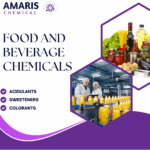
 Preservatives(food)
Preservatives(food) Flavor Enhancers
Flavor Enhancers Acidulants
Acidulants Sweeteners
Sweeteners Antioxidants
Antioxidants Colorants(food)
Colorants(food)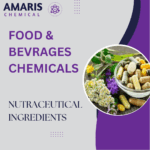 Nutraceutical Ingredients (food)
Nutraceutical Ingredients (food) Nutrient Supplements
Nutrient Supplements Emulsifiers
Emulsifiers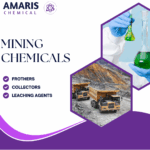
 Collectors
Collectors Dust Suppressants
Dust Suppressants Explosives and Blasting Agents
Explosives and Blasting Agents Flocculants and Coagulants
Flocculants and Coagulants Frothers
Frothers Leaching Agents
Leaching Agents pH Modifiers
pH Modifiers Precious Metal Extraction Agents
Precious Metal Extraction Agents
 Antioxidants(plastic)
Antioxidants(plastic) Colorants (Pigments, Dyes)
Colorants (Pigments, Dyes) Fillers and Reinforcements
Fillers and Reinforcements Flame Retardants
Flame Retardants Monomers
Monomers Plasticizers
Plasticizers Polymerization Initiators
Polymerization Initiators Stabilizers (UV, Heat)
Stabilizers (UV, Heat)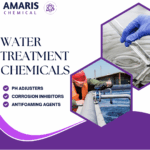
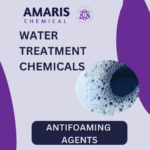 Antifoaming Agents
Antifoaming Agents Chelating Agents
Chelating Agents Coagulants and Flocculants
Coagulants and Flocculants Corrosion Inhibitors
Corrosion Inhibitors Disinfectants and Biocides
Disinfectants and Biocides Oxidizing Agents
Oxidizing Agents pH Adjusters
pH Adjusters Scale Inhibitors( water)
Scale Inhibitors( water)
 Antioxidants(cosmetic)
Antioxidants(cosmetic) Emollients
Emollients Fragrances and Essential Oils
Fragrances and Essential Oils Humectants
Humectants Preservatives
Preservatives Surfactants(cosmetic)
Surfactants(cosmetic) Thickeners
Thickeners UV Filters
UV Filters
 Fertilizers
Fertilizers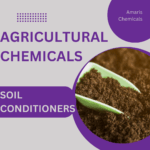 Soil Conditioners
Soil Conditioners Plant Growth Regulators
Plant Growth Regulators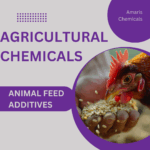 Animal Feed Additives
Animal Feed Additives Biostimulants
Biostimulants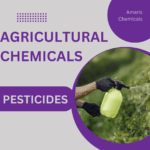 Pesticides (Herbicides, Insecticides, Fungicides)
Pesticides (Herbicides, Insecticides, Fungicides)
 Active Pharmaceutical Ingredients (APIs)
Active Pharmaceutical Ingredients (APIs) Excipients
Excipients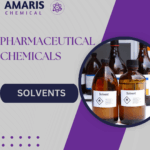 Solvents(pharmaceutical)
Solvents(pharmaceutical) Antibiotics
Antibiotics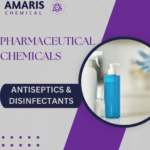 Antiseptics and Disinfectants
Antiseptics and Disinfectants Vaccine Adjuvants
Vaccine Adjuvants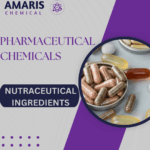 Nutraceutical Ingredients (pharmaceutical)
Nutraceutical Ingredients (pharmaceutical)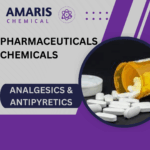 Analgesics & Antipyretics
Analgesics & Antipyretics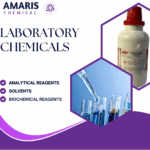
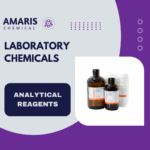 Analytical Reagents
Analytical Reagents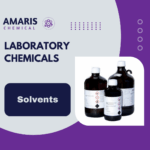 Solvents(lab)
Solvents(lab)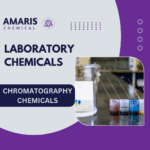 Chromatography Chemicals
Chromatography Chemicals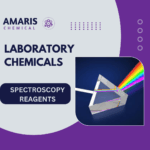 Spectroscopy Reagents
Spectroscopy Reagents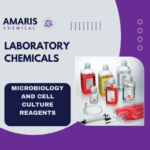 microbiology-and-cell-culture-reagents
microbiology-and-cell-culture-reagents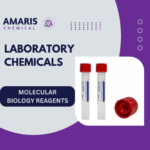 Molecular Biology Reagents
Molecular Biology Reagents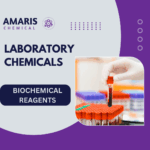 Biochemical Reagents
Biochemical Reagents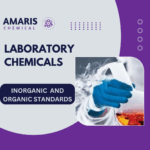 Inorganic and Organic Standards
Inorganic and Organic Standards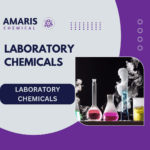 Laboratory Safety Chemicals
Laboratory Safety Chemicals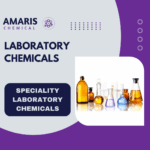 Specialty Laboratory Chemicals(Special Laboratory Equipment)
Specialty Laboratory Chemicals(Special Laboratory Equipment)
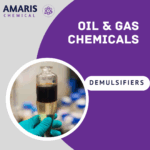 Demulsifiers
Demulsifiers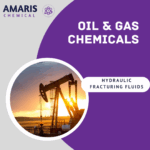 Hydraulic Fracturing Fluids
Hydraulic Fracturing Fluids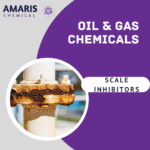 Scale Inhibitors(oil)
Scale Inhibitors(oil) Surfactants(oil)
Surfactants(oil)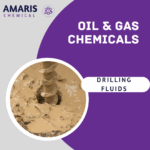 Drilling Fluids
Drilling Fluids
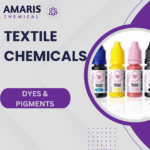 Dyes and Pigments
Dyes and Pigments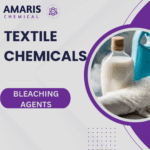 Bleaching Agents
Bleaching Agents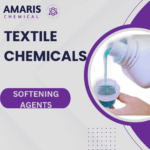 Softening Agents
Softening Agents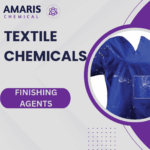 Finishing Agents
Finishing Agents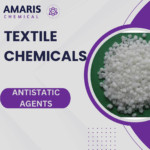 Antistatic Agents
Antistatic Agents
 Admixtures
Admixtures Waterproofing Agents
Waterproofing Agents Sealants and Adhesives
Sealants and Adhesives Curing Compounds
Curing Compounds Concrete Repair Chemicals
Concrete Repair Chemicals Anti-Corrosion Coatings
Anti-Corrosion Coatings
 Surfactants(cleaning)
Surfactants(cleaning) Builders
Builders Enzymes
Enzymes Solvents (Cleaning)
Solvents (Cleaning) Fragrances
Fragrances
 Electronic Chemicals
Electronic Chemicals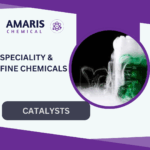 Catalysts
Catalysts Lubricants
Lubricants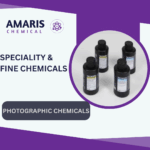 Photographic Chemicals
Photographic Chemicals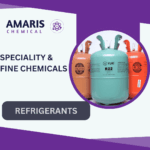 Refrigerants
Refrigerants Automotive chemicals
Automotive chemicals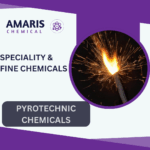 Pyrotechnic Chemicals
Pyrotechnic Chemicals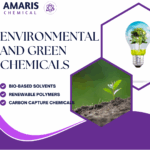
 Biodegradable Surfactants
Biodegradable Surfactants Bio-based Solvents
Bio-based Solvents Renewable Polymers
Renewable Polymers Carbon Capture Chemicals
Carbon Capture Chemicals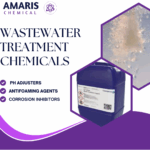 Wastewater Treatment Chemicals
Wastewater Treatment Chemicals
 Pigments
Pigments Solvents(paint)
Solvents(paint) Specialty Coatings
Specialty Coatings Binders/Resins
Binders/Resins Additives
Additives Driers
Driers Anti-Corrosion Agents
Anti-Corrosion Agents Functional Coatings
Functional Coatings Application-Specific Coatings
Application-Specific Coatings
 Fresh Herbs
Fresh Herbs Ground Spices
Ground Spices Whole Spices
Whole Spices Spice Blends
Spice Blends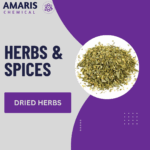 Dried Herbs
Dried Herbs
 Leavening Agents
Leavening Agents Dough Conditioners
Dough Conditioners Flour Treatments
Flour Treatments Fat Replacers
Fat Replacers Decoratives
Decoratives Preservatives(baking)
Preservatives(baking)
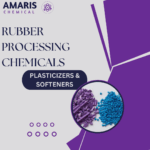 Plasticizers & Softeners
Plasticizers & Softeners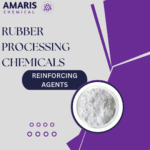 Reinforcing Agents
Reinforcing Agents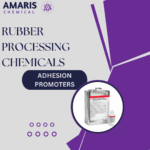 Adhesion Promoters
Adhesion Promoters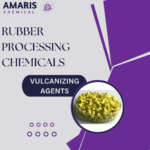 Vulcanizing Agents
Vulcanizing Agents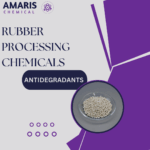 Antidegradants
Antidegradants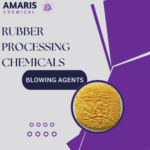 Blowing Agents
Blowing Agents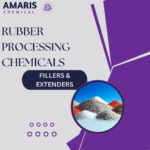 Fillers & Extenders
Fillers & Extenders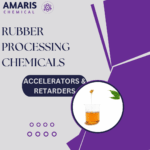 Accelerators & Retarders
Accelerators & Retarders
